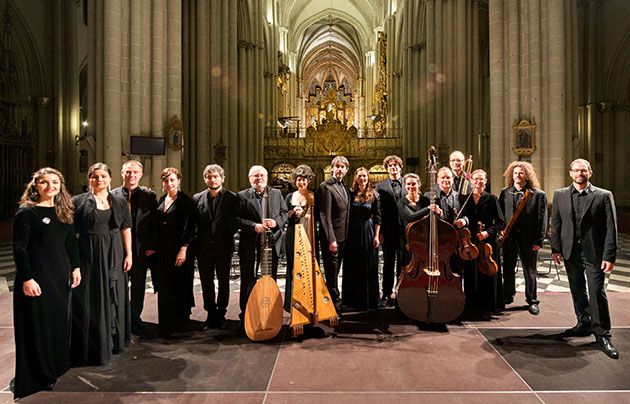Baroque Itinéraire I: Hidalgo, Patiño and the discovery of Durón
A fascinating programme of ‘Tonos’ and ‘Villancicos,’ the prevailing modes of expression for early 17th-century Spanish and Portuguese composers

Ton Koopman’s Baroque Itinéraire Festival in France’s beautiful Périgord returns to full force after a slimmed down version last year. Clement circumstance meant I was able to cover some of the 2022 festival; inclement circumstance meant only two days of the four, and that I had to miss the ‘Itinéraire' itself.
So here's the first concert:
Ouverture: Music for the Chapel Royal: Tonos and Villancicos. La Grande Chapelle / Albert Recasens (director). 28.07.2022
Juan Hidalgo (1614-1685) ¡Venid, querubines aladosl. Al dichoso nacer de me Niño. Anarda divina. Antorcha brillante. ¡Ay, corazón amantel. Aunque en el pan del cielo. Ay, cómo gime.
Carlos Patiño (1600-1675) Matizada flor del campo. Hoy mis penas confirman. Cantar las gracias de Flora. No puede amor hacer finezas.
Sebastián Durán (1660-1716) Cupidillo volante. Todo es enigmas amor. Segadorcillos que al son de las hoces. Vulcanes de amor …
Lucas Ruis de Ribayaz (before 1650) Españoleta
With one change of membership die to covid (Lucia Caiheuela replacing Mina Marcela López in the line-up), La Grande Chapelle embarked on a fascinating programme of ‘Tonos’ and ‘Villancicos,’ the prevailing modes of expression for early 17th-century Spanish and Portuguese composers. In Spain, during the reigns of Philip II, Philip IV and Carlos II, there flourished artists such as Rubens, Velázquez, Giordano and Calderón. The composers here represent the 17th century Spanish court therefore. While Juan Hidalgo might be the most famous of the names here to non-specialists, for this writer at least, it was the profundity of Sebastián Durón that shone like a black pearl, his profundity immediately obvious.

But first to Hidalgo. La Grande Chappelle under Racasens has recorded a disc of his music, Música para el Rey Planeta; it, like the recital here, began with the buoyant ¡Venid, querubines aladosi, a four-voice villancico full of life, the bright, glowing sopranos (Eugenia Boix and Caihuela) carrying the majority of melody; flowerings into full harmony were glorious. It was followed by a Christmas tono, Hidalgo’s Al dichoso nacer de me Niño, the music more tender, its rhythms nevertheless still buoyant. The supporting instrumental group comprised two violas da gamba (Sara Ruiz, Belisana Ruiz) and Spanish harp (Sara Aguedo), creating the perfect grounding (and decorative) support. His tender ¡Ay, corazón amantel, with a gentle accompaniment of harp, guitar and gamba offered not only beauty but a true narrational quality while Aunque en el pan del cielo with its extended opening for harp, theorbo and gamba offered pure elegance. Here’s a performance of Aunque
Interestingly (to my ears at least), Carlos Patiña's Matzcada flor del campo seemed to exist in a Venn diagram with the English madrigal tradition – there were definite intersections, if the music remained identifiably Spanis. The came Durón (again, there is a whole disc of Duron recorded by the present performers on the Lauda label), his Cupidillo volante (Solo al Santíssimo Sacramento). The music is shot through with emotion, and all credit to tenor Gerardo López-Gámez for the character of his delivery. Here‘s their performance from ‘FESTIMUVB‘ (Festival Música Vélez-Blanco):
This impression was confirmed later by Durón's Todo es enigmas amor, its meditation on the enigmas of love the perfect example of how La Grande Chapelle are basically fabulous story-tellers. Their sense of shape and drama is impeccable. The dancing but eloquent Segadorcillos que al son de las hoces is not only the height of compositional perfection, but also demonstrated the care lavished on these performances, the way the soprano differentiated subtly between each statement of a single syllable ‘Ta’; a little, but significant detail. It was Durón's ¡Volcanes de amor... that surely was the triumph of the evening, infectious in its cross-play of the word ‘fuego (fire)’. Utter delight from first to last. Here‘s their performance of ¡Volcanes de amor ... on their all-Durón disc on Lauda Música:
Subtlety is very much part of La Grande Chapelle; repeated phrases can be subtly and powerfully altered on repetition, and in imitation between voices one feels a real sense of conversation (Hidalgo’s Anarda divina demonstrated both trats perfectly). Their sound can positively glow (the tutti of Patiña's Hoy mis penas confirman).
There was an implied interval in the programme booklet, but the singers went straight through – rightly, as one could feel the audience engagement rising with each piece. Soprano Eugenia Boix’s extended solo in Hidalgo’s Antorcha Brillante was a masterpiece of beauty; as the other voices enter, it is like watching music in the act of flowering. Here's a performance by La Grande Chapelle from 2021, again at the Svatováclavsky Music Festival:
It was Hidalgo who had the last official word: ¡Ay, cómo gime!, nicely buoyant. The instrumental Españoleta by Lucas Ruiz de Ribayaz had punctuated the concert, and was the perfect palette refresher.
Hidalgo (La Grande Chapelle)